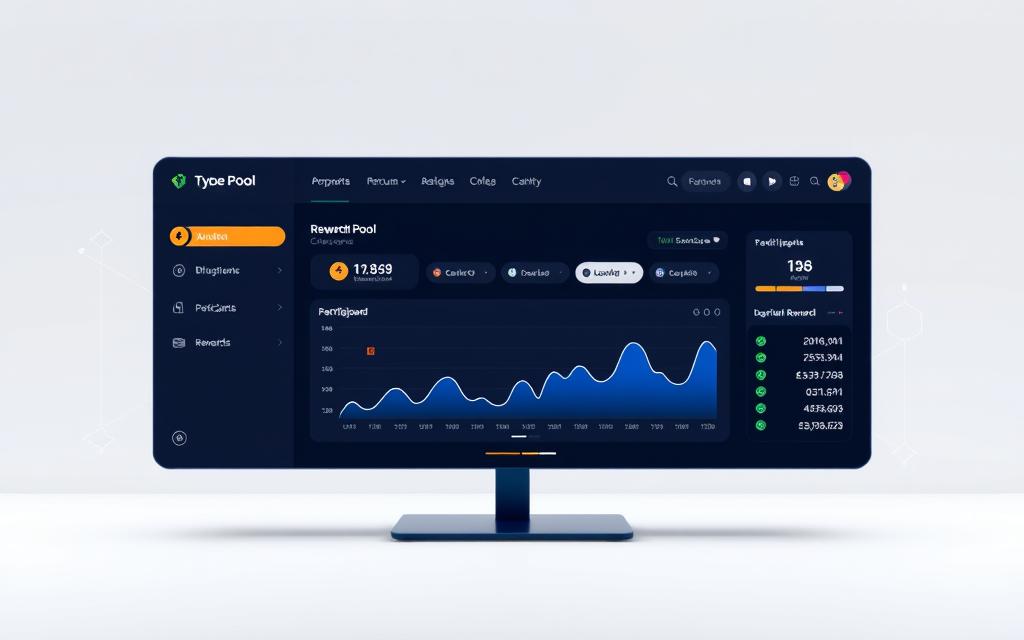Table of Contents
Digital asset platforms offer innovative ways to earn new tokens while supporting emerging blockchain ventures. By locking specific assets, participants gain access to freshly minted coins before public trading begins. This approach benefits both users and developers.
Platforms like Binance Launchpool demonstrate how exchanges bridge decentralized finance with centralized security. Over 50 million participants leverage these systems, creating immediate liquidity for crypto projects. Rewards update frequently, allowing flexible participation.
Unlike traditional fundraising methods, this model accelerates community growth. Early supporters receive direct token distribution for their contributions. Projects like Phemex showcase minimum requirements as low as 0.01 REVO, making entry accessible.
What Is a Launch Pool in Crypto?
Verified exchange users unlock opportunities to earn freshly minted tokens before market listings. These systems utilize smart contracts to automate rewards, ensuring transparency for participants. Unlike traditional savings accounts, yields often exceed 10% APY, attracting yield-focused investors.
Platforms like Binance employ dual-pool structures, allowing staking in BNB or FDUSD. This design enhances liquidity while catering to diverse asset preferences. Geographic restrictions apply, excluding users from certain U.S. states due to regulatory compliance.
Staked collateral fuels the token minting process, distributing rewards proportionally. Participants retain flexibility—unstaking incurs no penalties, and auto-compounding features maximize returns. Projects like Phemex offer 7–30 day staking periods, balancing accessibility with commitment.
“Launchpools bridge centralized security with DeFi’s capital efficiency, creating win-win scenarios for developers and supporters.”
By integrating with the broader DeFi ecosystem, these pools optimize asset utilization. Crypto holders gain exposure to vetted projects, while startups secure immediate community backing. The model exemplifies blockchain’s potential to democratize finance.
Key Benefits of Participating in a Crypto Launch Pool

Early supporters of blockchain ventures enjoy substantial perks through structured reward systems. Platforms like Binance showcase 500%+ APY opportunities, with tokens often surging 72% post-listing. This model outperforms traditional savings, offering micro-cap exposure without high entry barriers.
Exchange-vetted projects reduce risks compared to unaudited DeFi protocols. Users stake assets like BNB or stablecoins, earning token rewards proportional to their commitment. Recent examples include Axie Infinity’s 2021 Launchpool, where participants saw 10x returns within weeks.
“Launchpools democratize access to high-growth assets, combining institutional vetting with decentralized participation.”
Tax advantages emerge when receiving tokens via airdrops rather than purchases. Restaking mechanics amplify earnings, while pooled liquidity ensures smoother market entries. For users, this translates to diversified portfolios and early access to innovative projects.
How to Participate in a Crypto Launch Pool
Joining a token distribution event requires strategic preparation and platform knowledge. Users gain early access to vetted projects by staking assets like BNB or stablecoins. Exchanges such as Binance and Phemex simplify the process with structured steps.
Step 1: Set Up a Verified Account
Create a Binance account or use a compatible exchange. Complete KYC verification with government-issued ID and proof of address. Enable multi-factor authentication for added security.
Some platforms restrict participation by region. Check eligibility before depositing assets. Cold wallet integration is optional but recommended for large holdings.
Step 2: Choose a Project and Lock Assets
Review upcoming projects on the exchange’s Launchpool page. Binance requires a minimum stake of 0.01 BNB, while Phemex allows concurrent Launchpad participation.
Allocate funds wisely—some pools offer higher APY for longer commitments. Diversify across multiple locked assets to mitigate risk.
Step 3: Monitor and Claim Rewards
Track earnings via real-time dashboards. Rewards update hourly or daily, depending on the platform. Claim tokens manually or enable auto-compounding.
Integrate tax reporting tools to streamline documentation. Cross-chain compatibility ensures seamless transfers to external wallets.
“Strategic staking turns idle assets into high-yield opportunities, blending security with innovation.”
How Rewards Are Calculated in a Launch Pool
Token allocation mechanics determine how participants earn through staking platforms. Exchanges like Binance use hourly snapshots to measure committed assets, ensuring fair distribution. This method prevents last-minute deposits from skewing rewards.

Understanding Proportional Distribution
The system divides payouts based on two key factors:
- Staked asset amount
- Duration of participation
Binance’s formula illustrates this clearly:
| Variable | Impact | Example |
|---|---|---|
| Your Stake | 50 BNB | 5% of pool |
| Total Pool | 1,000 BNB | 100% allocation |
| Reward Period | 7 days | 168 snapshots |
| Daily Tokens | 10,000 | ~595 tokens earned |
“Hourly snapshots eliminate gaming strategies, creating equitable reward structures for all participants regardless of entry timing.”
Factors Affecting Your Earnings
Several elements influence final payout amounts:
- Whale activity: Large stakes dilute smaller participants’ shares
- APY fluctuations: Dynamic rates adjust based on total staked value
- Minimum thresholds: 0.01 token requirements prevent micro-transactions
Platforms implement vesting schedules to stabilize token distribution. Some projects release 25% immediately with remaining rewards unlocking weekly. This protects against market dumps while giving users consistent income streams.
Security Best Practices for Launch Pool Participation
Robust security protocols separate successful participants from vulnerable targets. Phishing scams drain $300M annually from DeFi platforms, making vigilance non-negotiable. Exchanges like Binance combat threats with $1B SAFU insurance to protect funds.

Hardware wallets add critical layers to account protection. Ledger or Trezor devices isolate private keys from online exposure. For large assets, cold storage remains the gold standard against remote exploits.
Always verify smart contract audits before staking. Platforms publishing CertiK or PeckShield reports demonstrate transparent processes. Whitelist withdrawal addresses to prevent redirects to malicious wallets.
- Enable session timeouts after 5–15 minutes of inactivity
- Restrict API keys to read-only permissions where possible
- Monitor for dusting attacks—micro-transactions tracking wallets
“Layer security like an onion—each protection tier reduces attack surfaces incrementally.”
Regulatory compliance checks ensure platform legitimacy. Verify licenses like NYDFS or FCA approvals. For added safety, prioritize pools offering insurance against smart contract failures.
Crypto Launch Pool vs. Launchpad: Key Differences
Investors evaluating blockchain fundraising methods often weigh launchpools against launchpads for optimal returns. Binance’s 2020 launchpool introduction created a distinct alternative to its 2019 Launchpad, with participants seeing 300% higher average ROI through staking models.

The core distinction lies in capital deployment. Launchpools let users stake existing assets like BNB to earn new tokens, while Launchpads typically require purchasing funds during token sales. This creates divergent risk profiles:
| Factor | Launchpool | Launchpad |
|---|---|---|
| Commitment | Asset staking (reversible) | Direct purchase (irreversible) |
| Lockup | Flexible (1-30 days) | Fixed (often 6+ months) |
| Allocation | Hourly snapshots | Lottery/FCFS systems |
Secondary markets react differently to each model. Projects launched via pools often see 72-hour volatility under 15%, compared to 40%+ swings for Launchpad listings. This stems from gradual distribution versus concentrated token releases.
“Combining both models yields strategic advantages—staking in pools provides early exposure, while Launchpad participation secures larger allocations at preset prices.”
Historical data shows Launchpools generate faster liquidity for exchange listings. The Sandbox’s 2021 event demonstrated this, with pool participants accessing tokens 14 days before public trading. Savvy investors often dual-participate, balancing immediate rewards with long-term holdings.
Conclusion
Blockchain fundraising continues evolving, offering users diverse opportunities to grow portfolios. Launchpools demonstrate rising institutional interest, with major exchanges allocating 15-20% of new listings to staking rewards.
Key trends show:
- Hybrid models merging security with higher yields
- Regulatory clarity improving in 70% of G20 nations
- Portfolios allocating 5-10% to vetted pools outperform benchmarks
For optimal results, diversify across platforms like LCX’s hybrid solutions. Start with small stakes to test strategies before scaling participation.
The future points toward deeper crypto integration with traditional finance. Early adopters gain first-mover advantages in this dynamic space.
FAQ
How does a crypto launch pool work?
A launch pool allows users to lock their assets, such as BNB or stablecoins, to earn newly listed tokens. Rewards are distributed based on the amount and duration of locked funds.
What are the benefits of joining a launch pool?
Participants gain early access to new tokens, earn passive income through rewards, and support emerging projects without direct investment risks.
Can I withdraw my assets during the staking period?
No, locked assets remain inaccessible until the staking period ends. Early withdrawal forfeits rewards.
How are rewards calculated in Binance Launchpool?
Rewards depend on the user’s share of the total locked assets and the project’s token distribution rules. Higher contributions yield larger payouts.
Is participating in a launch pool risky?
While locking assets carries minimal risk, token volatility post-launch may affect value. Always research projects before committing funds.
What’s the difference between a launch pool and a launchpad?
Launch pools reward users for staking existing assets, while launchpads involve purchasing new tokens directly, often through lotteries or subscriptions.
Do I need a verified account to join?
Yes, platforms like Binance require KYC verification to participate in token distribution events securely.
How often are new projects added to launch pools?
Frequency varies by exchange. Binance typically lists new projects monthly, offering fresh opportunities for crypto holders.









